At just a little over 80 km’s to the north of Bangkok you’ll find Thailand’s capital Ayutthaya, or at least it was until the late 18th century before it was moved to Bangkok. Ayutthaya is one of the most impressive ruined cities in Asia and a must see for anyone with an affinity to history. Wandering through this once-thriving ancient city will make you feel like you’ve stepped back in time.
 The Ayutthaya Kingdom existed from 1351 to 1767. In the 16th century, it was described by foreign traders as one of the biggest and wealthiest cities in the East. The court of King Narai (1656–1688) had strong links with that of King Louis XIV of France, whose ambassadors compared the city in size and wealth to Paris.
The Ayutthaya Kingdom existed from 1351 to 1767. In the 16th century, it was described by foreign traders as one of the biggest and wealthiest cities in the East. The court of King Narai (1656–1688) had strong links with that of King Louis XIV of France, whose ambassadors compared the city in size and wealth to Paris.
In foreign accounts, Ayutthaya was called Siam, but many sources say the people of Ayutthaya called themselves Tai, and their kingdom Krung Tai meaning “The Tai country.”
Ayutthaya began its hegemony by conquering northern kingdoms and city-states like Sukhothai, Kamphaeng Phet and Phitsanulok. Before the end of the 15th century, Ayutthaya launched attacks on Angkor, the great power of the region. Angkor’s influence eventually faded from the Chao Phraya River Plain while Ayutthaya became a new great power.
 Interestingly, the Kingdom of Ayutthaya was not a unified state but rather a patchwork of self-governing principalities and tributary provinces owing allegiance to the king of Ayutthaya under The Circle of Power, or the mandala system. These principalities might be ruled by members of the royal family of Ayutthaya, or by local rulers who had their own independent armies, having a duty to assist the capital when war or invasion occurred.
Interestingly, the Kingdom of Ayutthaya was not a unified state but rather a patchwork of self-governing principalities and tributary provinces owing allegiance to the king of Ayutthaya under The Circle of Power, or the mandala system. These principalities might be ruled by members of the royal family of Ayutthaya, or by local rulers who had their own independent armies, having a duty to assist the capital when war or invasion occurred.
Foreign trade brought Ayutthaya not only luxury items but also new arms and weapons. In the mid-17th century, during King Narai’s reign, Ayutthaya became very prosperous. In the 18th century, Ayutthaya gradually lost control over its provinces. Provincial governors exerted their power independently, and rebellions against the capital began.
After a bloody period of dynastic struggle, Ayutthaya entered into what has been called the golden age, a relatively peaceful episode in the second quarter of the 18th century when art, literature, and learning flourished. There were foreign wars. Ayutthaya fought with the Nguyễn Lords (Vietnamese rulers of south Vietnam) for control of Cambodia starting around 1715. But a greater threat came from Burma, where the new Alaungpaya dynasty (Konbaung dynasty) had subdued the Shan states.
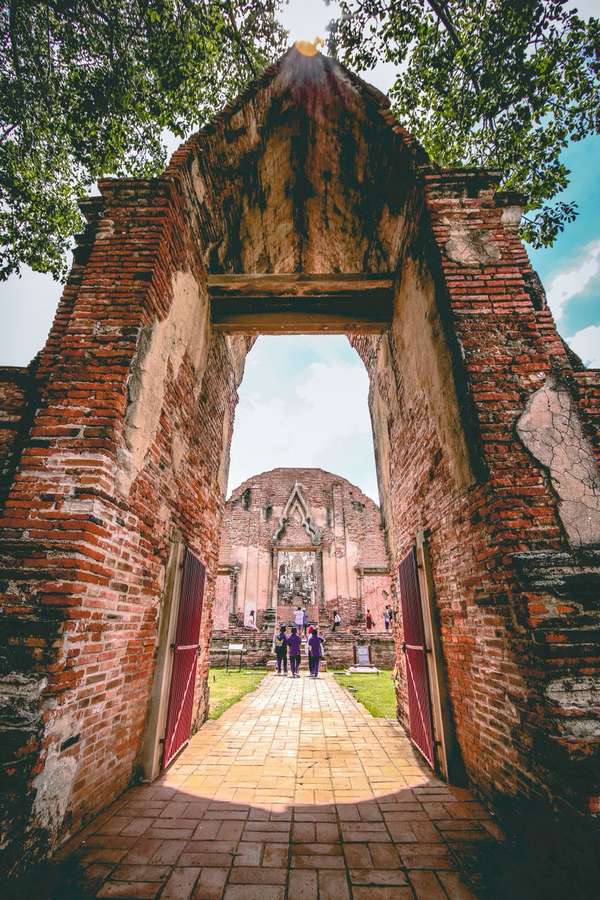 The last fifty years of the kingdom witnessed a bloody struggle among the princes. The throne was their prime target. Purges of court officials and able generals followed. The last monarch, Ekathat, originally known as Prince Anurakmontree, forced the king, who was his younger brother, to step down and took the throne himself.
The last fifty years of the kingdom witnessed a bloody struggle among the princes. The throne was their prime target. Purges of court officials and able generals followed. The last monarch, Ekathat, originally known as Prince Anurakmontree, forced the king, who was his younger brother, to step down and took the throne himself.
In 1765, a combined 40,000-strong force of Burmese armies invaded the territories of Ayutthaya from the north and west. Major outlying towns quickly capitulated. After a 14 month siege, the city of Ayutthaya capitulated and was burned in April 1767. Ayutthaya’s art treasures, the libraries containing its literature, and the archives housing its historic records were almost totally destroyed, and the Burmese brought the Ayutthaya Kingdom to ruin.
The Burmese rule however lasted only a few months as they had also been fighting a simultaneous war with the Chinese and were forced to withdraw in early-1768 when Chinese forces threatened their own capital.
With most Burmese forces having withdrawn, the country was reduced to chaos. All that remained of the old capital were some ruins of the royal palace. Provinces proclaimed independence under generals, rogue monks, and members of the royal family.
One general, Phraya Taksin, former governor of Tak, began the reunification effort. He gathered forces and began striking back at the Burmese. He finally established a capital at Thonburi, across the Chao Phraya from the present capital, Bangkok. Taksin ascended the throne, becoming known as King Taksin.
The ruins of the historic city of Ayutthaya and “associated historic towns” in the Ayutthaya historical park have been listed by UNESCO as a World Heritage Site.
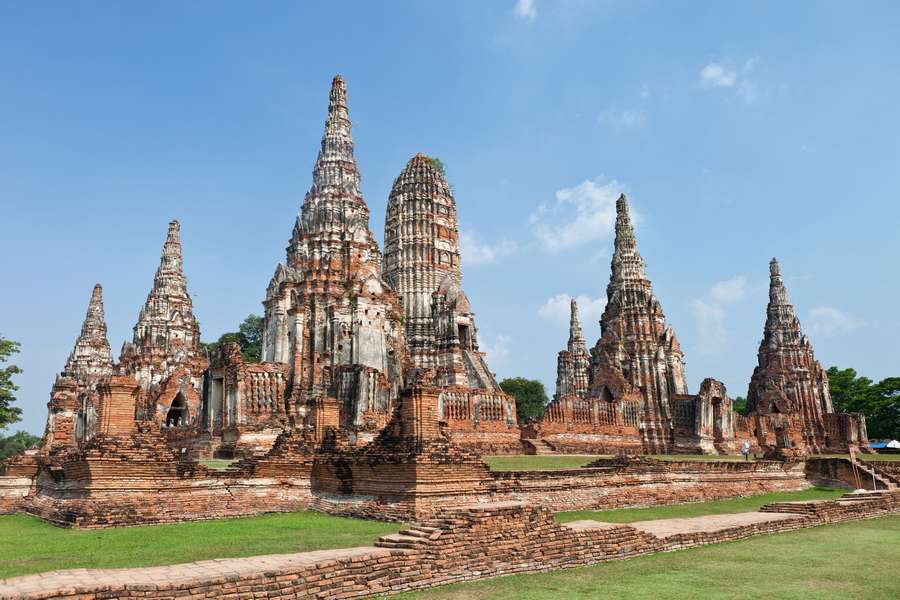 When visiting Ayutthaya there is a lot to see but a few sites you should definitely check out include Wat Chaiwatthanaram. Restoration began here in 1987 taking it from a looted ruin to one of the most visited attractions in the Ayutthaya Historical Park. This large complex on the west bank of the Chao Phraya river is one of Ayutthaya’s most impressive temples and offers insight into the influence of Buddhism on the Thai community. Built in the traditional Khmer style, the complex consists of a central prang or spire perched atop a rectangular base amid four smaller prang and eight chedi-like temples or merus. Reliefs portraying scenes from the life of the Buddha once adorned the exterior of the merus, but only fragments now remain. Sunset is an especially beautiful time to visit, when the buildings glow in the late light.
When visiting Ayutthaya there is a lot to see but a few sites you should definitely check out include Wat Chaiwatthanaram. Restoration began here in 1987 taking it from a looted ruin to one of the most visited attractions in the Ayutthaya Historical Park. This large complex on the west bank of the Chao Phraya river is one of Ayutthaya’s most impressive temples and offers insight into the influence of Buddhism on the Thai community. Built in the traditional Khmer style, the complex consists of a central prang or spire perched atop a rectangular base amid four smaller prang and eight chedi-like temples or merus. Reliefs portraying scenes from the life of the Buddha once adorned the exterior of the merus, but only fragments now remain. Sunset is an especially beautiful time to visit, when the buildings glow in the late light.
 Another temple you won’t want to miss is Wat Phra Si Sanphetas, it is the most historically important temple in old Ayutthaya. Its three large chedis and numerous smaller ones make this Wat, also known as the King’s Temple, one of the most impressive sights in the ruined city. Two of the large chedis, the eastern and central ones, were built in 1492 by King Ramathibodi II to house the ashes of his father and elder brother. His own ashes are interred in the third chedi, built in 1530 by his son and royal successor, King Boromaraja IV.
Another temple you won’t want to miss is Wat Phra Si Sanphetas, it is the most historically important temple in old Ayutthaya. Its three large chedis and numerous smaller ones make this Wat, also known as the King’s Temple, one of the most impressive sights in the ruined city. Two of the large chedis, the eastern and central ones, were built in 1492 by King Ramathibodi II to house the ashes of his father and elder brother. His own ashes are interred in the third chedi, built in 1530 by his son and royal successor, King Boromaraja IV.
All three chedis were plundered by the Burmese, though they failed to find the hundreds of small Buddha statues in bronze, crystal, silver, lead, and gold now on display in the National Museum, one of the top attractions in Bangkok. Other smaller Buddha figures were also taken to the capital to be placed in Wat Buddhaisawan.
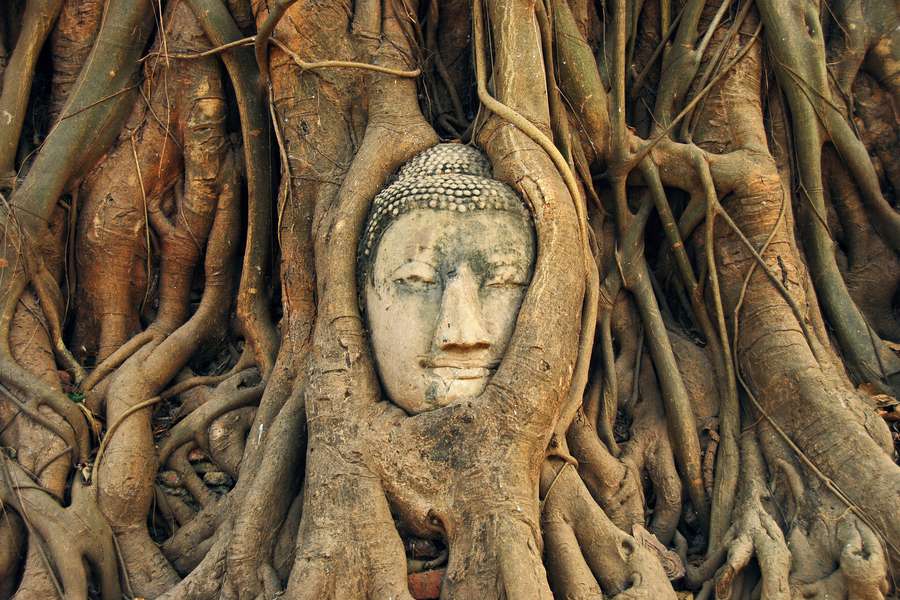 Wat Mahathat is also definitely worth a visit. Widely believed to be built by King Ramesuan around 1384, its most famous feature is the face of a stone Buddha peeking out from among the roots at the base of a tree. The central prang here is one of the old city’s most impressive edifices. In about 1625, the top portion broke off, being rebuilt in 1633 some four meters higher than before. Later, it collapsed again and only the corners survived. In 1956, a secret chamber was uncovered in the ruins. Among the treasures found inside were gold jewelry, a gold casket containing a relic of the Buddha, and fine tableware.
Wat Mahathat is also definitely worth a visit. Widely believed to be built by King Ramesuan around 1384, its most famous feature is the face of a stone Buddha peeking out from among the roots at the base of a tree. The central prang here is one of the old city’s most impressive edifices. In about 1625, the top portion broke off, being rebuilt in 1633 some four meters higher than before. Later, it collapsed again and only the corners survived. In 1956, a secret chamber was uncovered in the ruins. Among the treasures found inside were gold jewelry, a gold casket containing a relic of the Buddha, and fine tableware.
One thing to be conscious of when visiting the many temples in Ayutthaya is to be respectful, especially when taking photos. Just as you wouldn’t want foreigners rudely posing for pictures in your places of worship, Thai’s take strong offence to that same type of behavior.
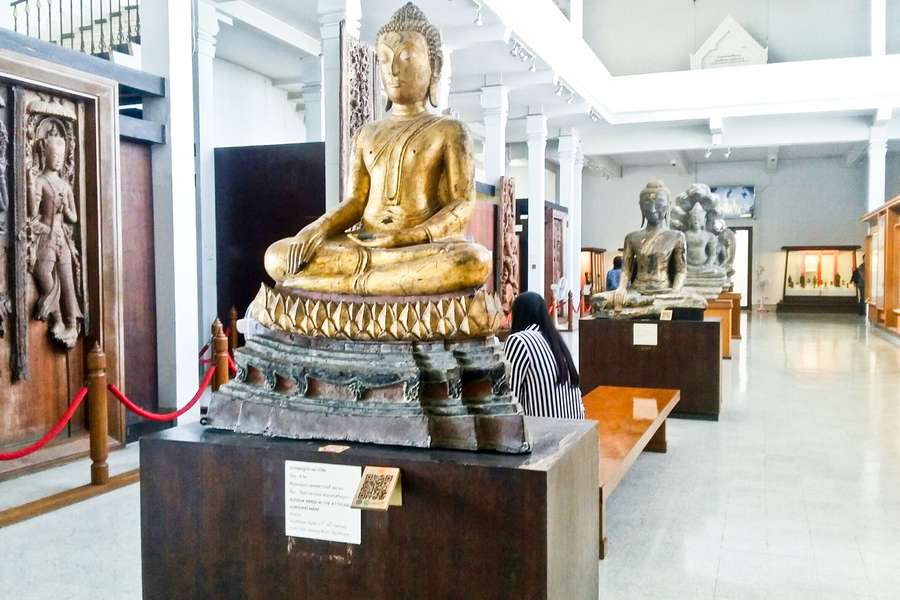 If you are ready to take a break from temple viewing then check out the Chao Sam Phraya National Museum. Set in several buildings surrounded by lily ponds, the museum was founded by King Bhumibol Adulyadej in 1961. It houses a number of sculptures and works from different periods throughout Thailand’s early history, including several superb golden Buddha statues; gold jewelry and utensils, and ornate teak friezes. Highlights are a seated Buddha and a huge bust of the Buddha in the U Thong style.
If you are ready to take a break from temple viewing then check out the Chao Sam Phraya National Museum. Set in several buildings surrounded by lily ponds, the museum was founded by King Bhumibol Adulyadej in 1961. It houses a number of sculptures and works from different periods throughout Thailand’s early history, including several superb golden Buddha statues; gold jewelry and utensils, and ornate teak friezes. Highlights are a seated Buddha and a huge bust of the Buddha in the U Thong style.
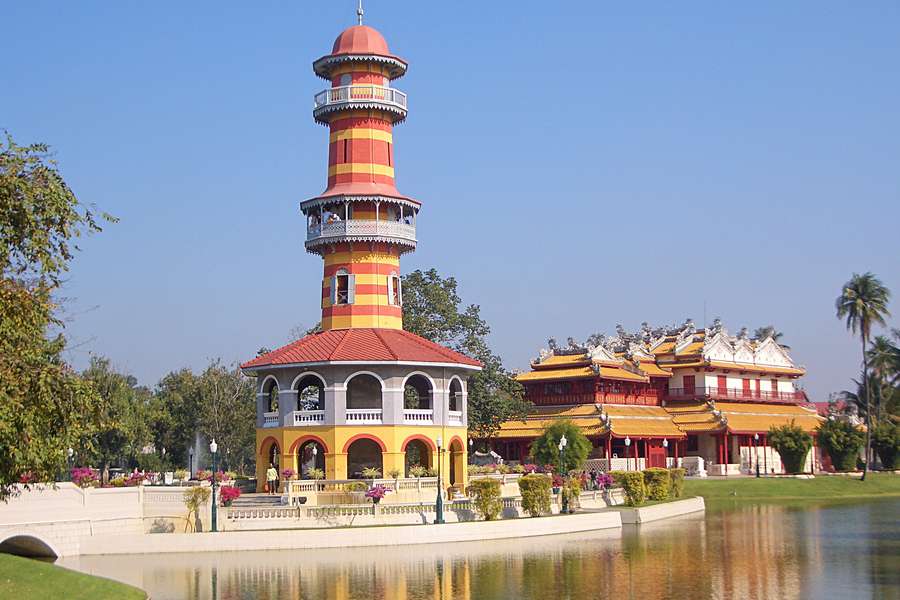 Another site worth seeing is the Bang Pa-in Palace, which dates back to the 17th century. Also known as the Summer Palace, this royal residence is one of the best-preserved compounds in the area. The buildings feature several architectural styles, including traditional Thai and Chinese structures, and there’s also Phra Thinang Uthayan Phumisathian – a two-story Victorian style mansion. Another interesting spot is Ho Witthunthassana, the three-story, tower-style building used for scoping out the countryside and watching for royal elephants.
Another site worth seeing is the Bang Pa-in Palace, which dates back to the 17th century. Also known as the Summer Palace, this royal residence is one of the best-preserved compounds in the area. The buildings feature several architectural styles, including traditional Thai and Chinese structures, and there’s also Phra Thinang Uthayan Phumisathian – a two-story Victorian style mansion. Another interesting spot is Ho Witthunthassana, the three-story, tower-style building used for scoping out the countryside and watching for royal elephants.
 While in Ayutthaya you’ll want to be sure to avail yourself of the many restaurants lining the river serving traditional Thai food. Here your guaranteed to find new Thai dishes that you have never tried before. One dish in particular to try is the delicious original Ayutthaya noodle in black soup. If your stay is over the weekend be sure to check out their new night market open on weekends only. What’s interesting about this market is that most people walk around in traditional Thai costumes, not just the vendors but visitors alike. The Thai costumes can be rented at the market for very small money. Additional things worthwhile doing while there is renting a long tail boat for a river cruise and renting bikes to tour the city.
While in Ayutthaya you’ll want to be sure to avail yourself of the many restaurants lining the river serving traditional Thai food. Here your guaranteed to find new Thai dishes that you have never tried before. One dish in particular to try is the delicious original Ayutthaya noodle in black soup. If your stay is over the weekend be sure to check out their new night market open on weekends only. What’s interesting about this market is that most people walk around in traditional Thai costumes, not just the vendors but visitors alike. The Thai costumes can be rented at the market for very small money. Additional things worthwhile doing while there is renting a long tail boat for a river cruise and renting bikes to tour the city.
 If you have yet to visit Ayutthaya, it’s a “bucket list” worthy destination and not that difficult to get to. There is a lot to see here and we suggest you spend at least two days to see all the sites and longer if you don’t want to feel rushed.
If you have yet to visit Ayutthaya, it’s a “bucket list” worthy destination and not that difficult to get to. There is a lot to see here and we suggest you spend at least two days to see all the sites and longer if you don’t want to feel rushed.


